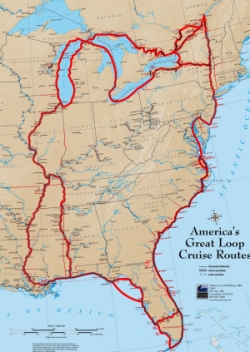 Buying a motor yacht and planning to circumnavigate Eastern North America with little or no experience with boats is a little wacky. Our first and only real boating experience a few years earlier had been chartering a thirty-foot faux tug and cruising through the Trent-Severn Waterway in Ontario, Canada, with Eva’s sister, Lelia, and her husband. While there we met a couple in Bobcaygeon aboard a boat from Norfolk, VA. When we questioned them about their trip, we realized that the Eastern part of North America is just a big island.
Buying a motor yacht and planning to circumnavigate Eastern North America with little or no experience with boats is a little wacky. Our first and only real boating experience a few years earlier had been chartering a thirty-foot faux tug and cruising through the Trent-Severn Waterway in Ontario, Canada, with Eva’s sister, Lelia, and her husband. While there we met a couple in Bobcaygeon aboard a boat from Norfolk, VA. When we questioned them about their trip, we realized that the Eastern part of North America is just a big island.
Soon after that Canadian trip and discontent at her hospital job, Eva began to fantasize about getting a boat and cruising America’s coastal and inland waters. I pretended not to hear those early pleadings because the proposition was preposterous, but the house began to fill with books and magazines on boating and it became evident that she wouldn’t quit!
I was 61, Eva was 51. If we were ever going to circumnavigate Eastern North America (called the Great Loop or Great Circle, by some), we simply had to get on with it. We lived on the central coast of California where I was a newspaper stringer and had travel writing and photography experience, and Eva was a good photographer with expertise in proof reading and copyediting. We thought we could combine pleasure with work and amass a bunch of stories to sell to magazines and newspapers. We got the cameras ready; voice recorders were close by; all we needed to do was to keep the boat afloat and not hit anything.
 To ease ourselves into boating we took a series of courses with the U.S. Power Squadrons and the U.S. Coast Guard Auxiliary. Both organizations sound academic and technical, but the local Power Squadron was comprised of mostly ordinary folks who fool around on boats and offer a variety of courses on navigational topics and boating safety. After a couple of years, they educated us as we hung around with them, spent time on their boats and, soon we planned to be out there on the water on our own.
To ease ourselves into boating we took a series of courses with the U.S. Power Squadrons and the U.S. Coast Guard Auxiliary. Both organizations sound academic and technical, but the local Power Squadron was comprised of mostly ordinary folks who fool around on boats and offer a variety of courses on navigational topics and boating safety. After a couple of years, they educated us as we hung around with them, spent time on their boats and, soon we planned to be out there on the water on our own.
We bought the boat in Ft. Lauderdale, FL, flew there February first, and spent a few weeks learning about the systems, making repairs and additions, and outfitting the boat for living aboard. The plan was to spend the spring going northward along the Atlantic Intracoastal Waterway, arriving in New York around the first of June. We’d spend the summer in Canada, cruising the Great Lakes from East to West, arriving in Chicago around the first of September. The fall would see us meandering down the inland rivers, arriving in Mobile, AL, around the first of November and back to our starting point by December.
 It wasn’t going to be a blue water voyage to the Galapagos, but it was setting “sail” on a forty-foot long, fourteen-foot wide scow with a couple of diesels in her belly and two virgins at the helm. We’d do about 150 miles a week for ten months and be gone for most of a year. The whole concept and skill set of living aboard a moving platform in tides, wind and currents and with a different address every night was not fully comprehended.
It wasn’t going to be a blue water voyage to the Galapagos, but it was setting “sail” on a forty-foot long, fourteen-foot wide scow with a couple of diesels in her belly and two virgins at the helm. We’d do about 150 miles a week for ten months and be gone for most of a year. The whole concept and skill set of living aboard a moving platform in tides, wind and currents and with a different address every night was not fully comprehended.
Boats are an engineers dream… and an enigma to the rest of us. Boats break, and they break when there isn’t a mechanic around. It’s you and the diesels and the water pumps and regulators and packing glands and a million other esoteric boat parts that you’ve never seen before and have no idea how they work, let alone fix. I hate plumbing, electricity is an enigma, and my tool chest is a mishmash of stuff.
My designated engine maintenance outfit was soon splattered with oil squirts, streams of blood and tear stains on the sleeves. Boats are self-contained cities. They have the passengers, their food, their waste, water – both good and very bad, galley (kitchen) waste, engine exhaust, oil leaks, water leaks, an HVAC system and hot and screaming bearings that cry if they’re not oiled.

Leave a Reply